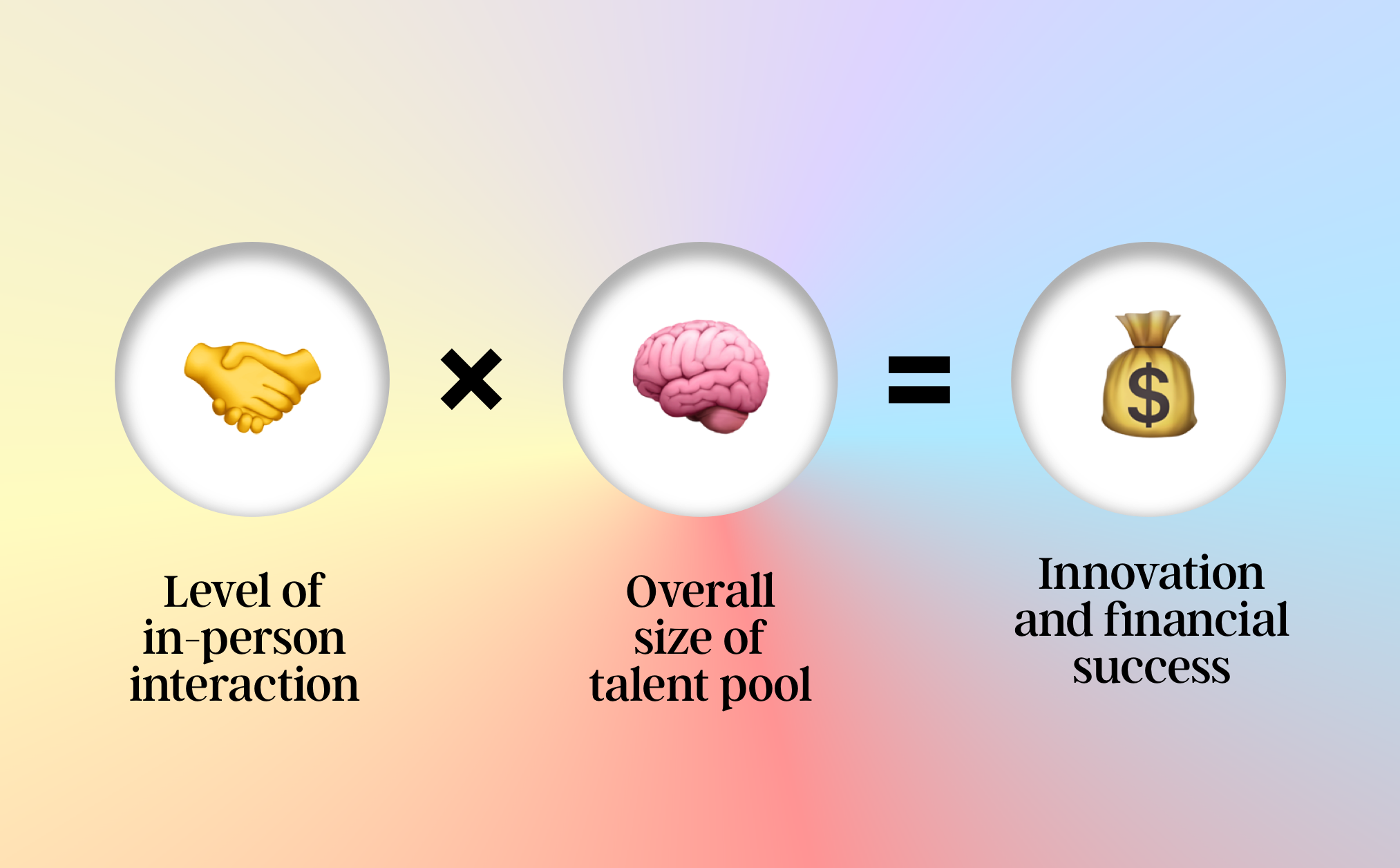The Talent Equation
In-person interaction contributes to creativity. But is it enough to offset a shortage of talent?

The vaccine is upon us, and some companies are re-rethinking their office strategy. Earlier this week, Amazon anounced:
"Our plan is to return to an office-centric culture as our baseline. We believe it enables us to invent, collaborate, and learn together most effectively."
Several other companies announced similar plans, and Goldman Sachs's CEO went as far as calling remote work an "aberration".
Other companies are ready to double down on the COVID experiment. In a LinkedIn post, Twitter's VP of Workplace and Remote Experience went on encouraged employees who are forced to go back to the office to stay remote and apply for a job at Twitter instead.
Over the past two decades, the working assumption was that large urban centers are more productive because:
- They enable "knowledge spillovers" and spontaneous interactions between people, which, in turn, lead to new ideas. As Edward Glaeser puts it, "the core idea at the center of information-based agglomeration economies is that all of our knowledge builds on things that we learn from people around us;" and
- They have deep labor pools that facilitate better matching of candidates to jobs. As Enrico Moretti pointed out, better matching results in higher salaries for employees and higher profits for employers. The size of the talent pool "is particularly important for workers with highly specialized skills, such as high-tech engineers, scientists, mathematicians, designers, and doctors."
These two factors multiply one another. In-person interaction between well-matched employees produces better and faster economic growth.
The post-Covid world puts these factors on a collision course. The relative importance of each of them will determine how many companies end up embracing remote work and, more broadly, which companies and regions will thrive over the next decade.
Consider the case of Amazon. After it announced a return to "office-centric culture", some employees started to complain and even threatened to leave. The average Amazon engineer earns around $200,000 or so in salary, bonuses, and equity grants per year, and often much more than that. If some employees leave, Amazon will likely find others to fill their place.
There are enough other engineers in Seattle, New York, and Arlington — where Amazon has HQs — that would be happy to show up at the office every day and earn an Amazon-level salary. The problem is that by insisting that people show up at the office every day, Amazon is limiting itself to a much smaller talent pool: It can hire only people who live near its HQs and who are happy to work regularly at the office.
Note that this means that the talent pool around Amazon's HQs is not just equal to its pre-Covid size. This pool is likely smaller now. As I pointed out in The Office Prisoner's Dilemma, the Covid experiment drove more people to identify explicitly as remote workers. Some of these people have already left the (expensive) cities in which Amazon is located. More importantly, even those that stayed are not going to agree to work for Amazon.
Amazon is doubling down on in-person interaction at the expense of access to a smaller talent pool.
Twitter is taking the opposite bet. It is doubling-down on remote work — on access to a much bigger talent pool — at the expense of fewer in-person interactions between its employees.
Which approach would win out?
Let's go back to the equation: [The level of in-person interaction] multiplied by [the size of the talent pool] equals [The rate of innovation and financial success]. Amazon chose to maintain the level of in-person interaction and reduce the size of the talent pool. Twitter chose to dramatically reduce the level of in-person interaction and dramatically increase the size of the talent pool from which it hires.
Different approaches would work for different companies, and I doubt Amazon will remain as dogmatic about the office as it plans to be. But, all things being equal, I would bet on the size of the talent pool being much more important. I have not seen research that compares the relative importance of these two factors. For me, the following points tip the scale:
- Remote employees still get to meet each other as well as other people every now and then. This builds trust, at least at a minimal level.
- There are already innovative companies that manage to work in a completely distributed fashion (and even Amazon itself has become more distributed over the past decade, splitting its HQ to increase its reach — as did many other tech giants).
- Meanwhile, I am not aware of a single giant tech company that can grow without accessing an increasing large talent pool (in absolute terms and relative to the pools its competitors access).
- Tools that enable remote collaboration will only get better.
- Meanwhile, specialization will only become more important in knowledge industries, which means the talent pool's size will also become more important.
In other words, technology — an unstoppable force — will become better and better at mitigating the shortcomings of remote or hybrid work, and it will continue to intensify the drawbacks of hiring from a small talent pool.
What's your bet? Let me know on Twitter @drorpoleg
Have a great weekend.
Old/New by Dror Poleg Newsletter
Join the newsletter to receive the latest updates in your inbox.

